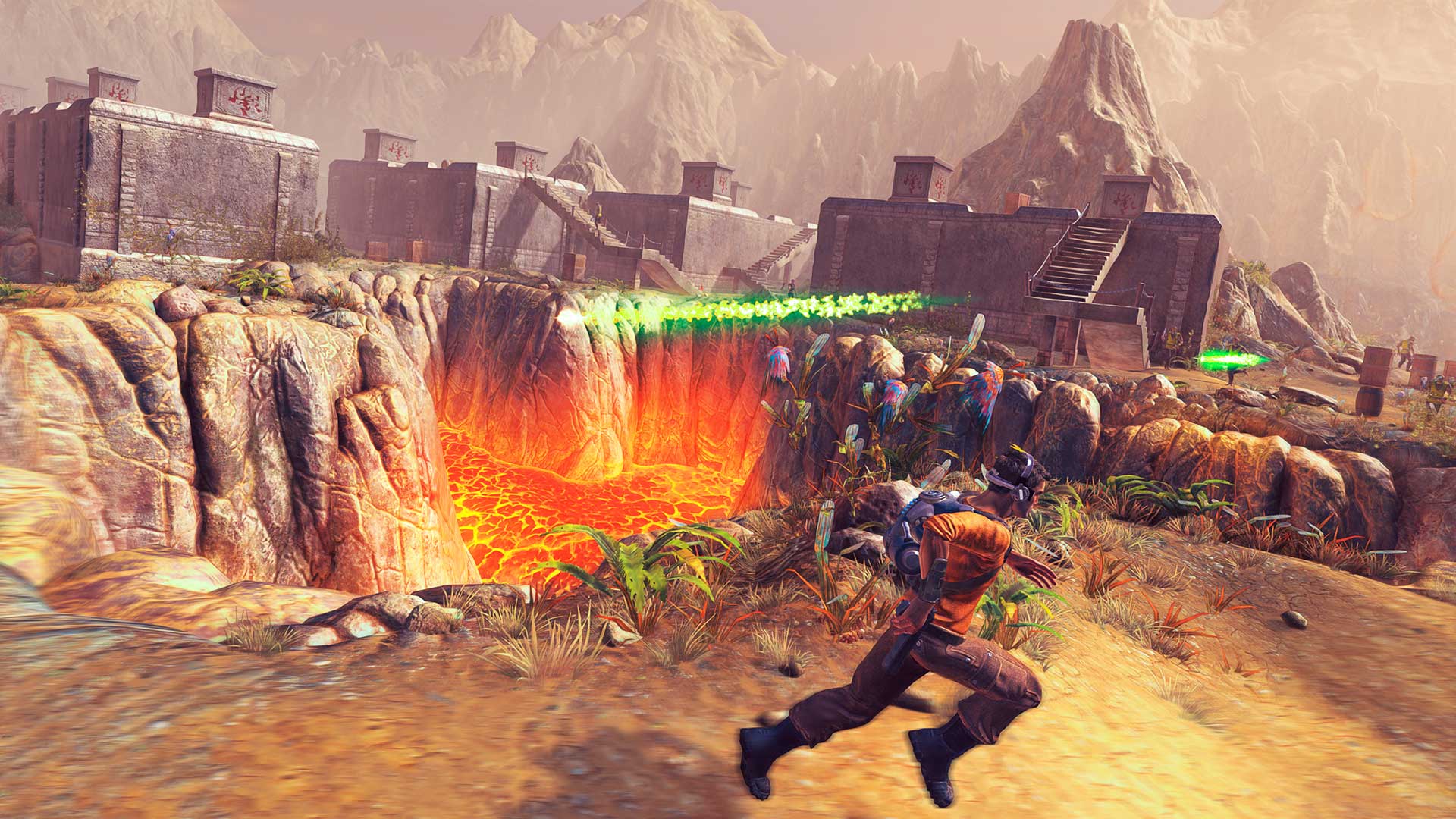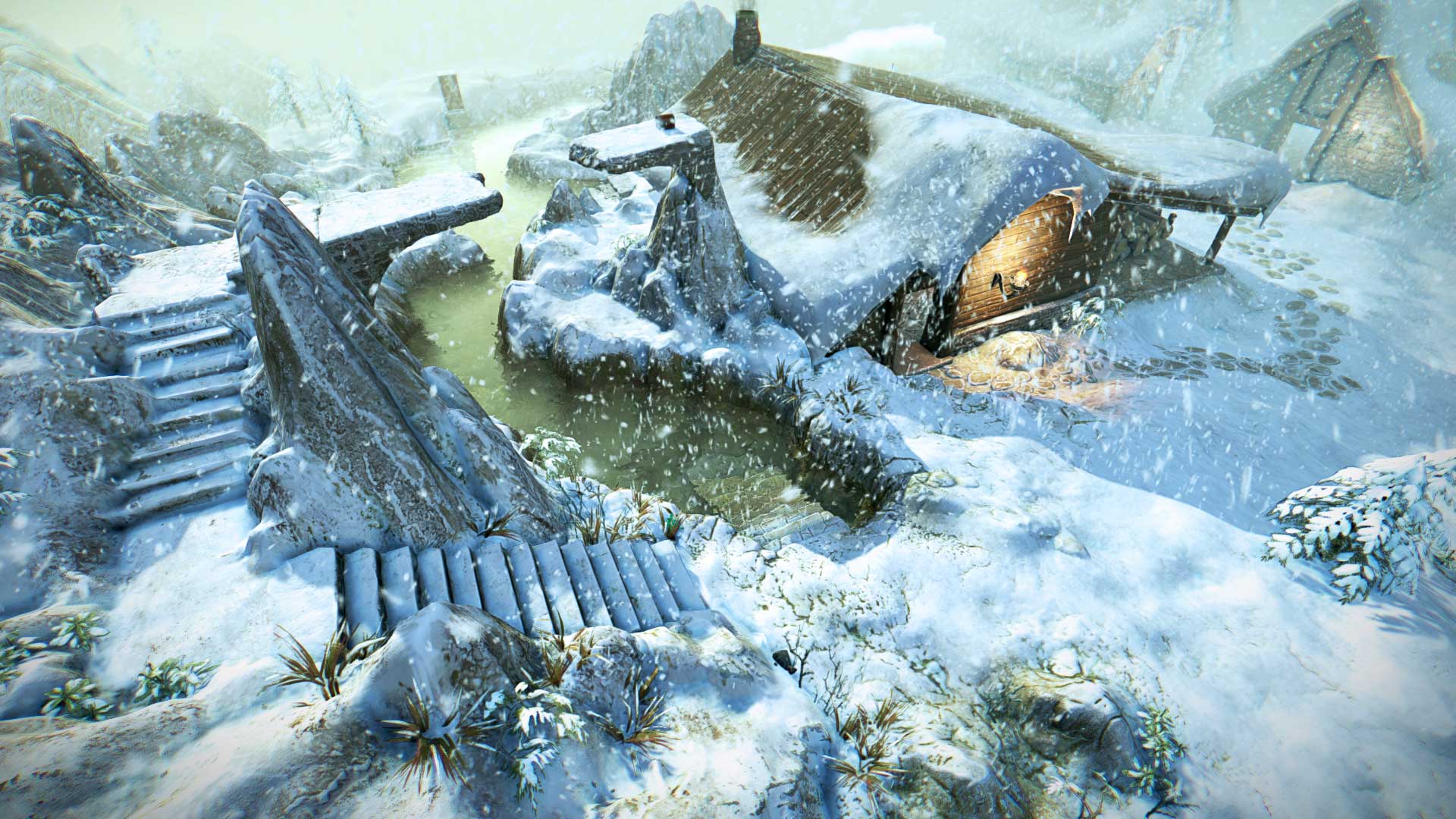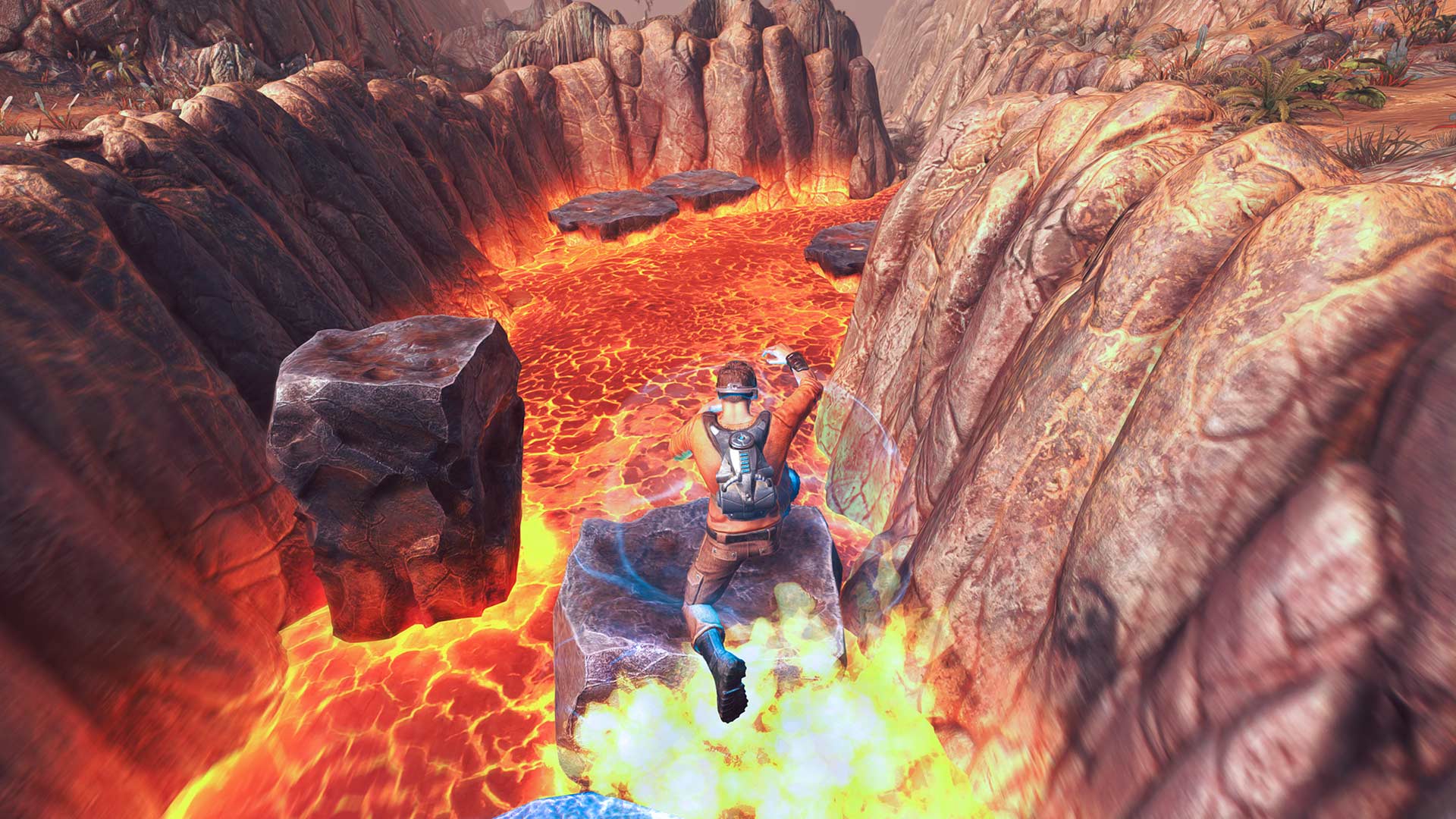
When Outcast first released in 1999, it was unlike most games at the time. It featured a huge world and oodles of freedom, allowing you go anywhere. If you wanted to participate in the main story, that was fine as well but in terms of free 3D exploration, it was one of a kind. Seeing Outcast: Second Contact, a remake of the original, made us think whether it still had a place in today’s industry of open world titles and 3D sandboxes.
To find out what’s new while the game stays true to its precedessor, GamingBolt spoke to developer Appeal about everything from the series’ everlasting appeal to the different features that define Outcast: Second Contact.
"With Outcast, we wanted to create a world that felt consistent and that you could explore freely and interactively."
What happened after Outcast HD failed to secure funding? How did you go about raising the money and why did you settle on Outcast: Second Contact?
The Outcast HD Kickstarter raised about $270.000 from over 5,100 fans. It’s nowhere near the goal we had set, but looking back at it, it’s still an amazing pledge. From the beginning of the campaign, we knew that we were lacking content and that the goal was high. It was our first crowd funding campaign and we were inspired by the same thirst for adventure, the same craziness, maybe the same over-confidence, that 15 years ago led us to create the original game.
On the days following the campaign we analyzed in detail what we did wrong. As crazy as it might appear, when the dust settled, this failure actually strengthened our spirit. The feedback from the players, the fans and the press had been great! We were now positive: Outcast needed a proper remake. So we all went back to work. Our priority was to have an early prototype to show. That plus the good buzz we had from the Kickstarter made it much easier to find a publisher to fund the project. Second Contact is that same remake project, but with a larger scope and more improvements.
What is it about the franchise that’s endured through the ages among its loyal fans?
From the feedback we got from our incredible community, there is something about the world that feels alive and unique. And that’s what we’ve tried to pursue as a studio since the 90s: to create fun and multifaceted living worlds through intelligent systems and interactive narration.
With Outcast, we wanted to create a world that felt consistent and that you could explore freely and interactively. One thing leading to another and we had to create a lot of gameplay pieces that came together as the game you know. For instance, each alien has its own backstory and behaviors, and your actions will have an impact on them. In a sense, Outcast was the result of that core ‘living world” idea pushed to its limits. We were not consciously creating an open-world video game, we just happened to make it because it made sense at that time.
How do you stay true to the spirit of Outcast while still innovating in Second Contact? Is there a fine line to walk?
As developers, working on our own game’s remake had been very difficult on our nerves at times! Should we try to be as truthful to the original game as possible, or should we modernize everything? Between nostalgia and progress, it’s definitely a fine line to walk.
Our goal was to try to re-create the same awe-inspiring experience for modern players, even for those with high AAA games standards in mind. Most of the narrative material was there already, so we focused on modernizing and enhancing the look and feel of the game. That means better graphics and more dynamic gameplay. Our goal is for both fans of the game and newcomers to enjoy playing it.
"To improve accessibility for new players we opted for an easier to follow shoulder camera and for a natural aim assist."
What does the open world hold for players? How big is it and what will they be able to do?
Outcast – Second Contact world is the exact replica of the original game. In fact, the level design is handled by the original code, running in C++, and communicating with the new game engine. You’ll find 6 regions of Adelpha, each very different from one another and you’ll be able to access them all from the start of the game. Exploring those regions and accomplishing quests will both push the story-line forward and allow you to gear up and weaken the enemy faction of the game. As a pioneer in the action-adventure game, Outcast offer you a very diverse experience: you’ll explore, fight, trade, climb, negotiate, loot, ride alien creatures, swim, solve puzzles and much more.
How did you significantly expand and add on to the base game’s world? Will there be new things to do and look forward to?
Outcast – Second Contact is a truthful remake of the original game. Our goal is to deliver the same experience to modern players. We are adding a few things and improved the graphics, but more than anything, we are making all the subtleties of the original game visible for new players through accessibility helps. Adelpha (the planet you explore in Outcast) is a systemic world where all your actions have a direct consequence on the balance of the world. We made that clear through visual indications popping up on the heads-up display and the onboard-computer interface. To cope with the more dynamic gameplay and faster gunfights, we also added new moves such as the dodge roll.
What can you tell us about the change to controls?
Outcast was a PC only game, so we reworked the control to feel native on consoles. To improve accessibility for new players we opted for an easier to follow shoulder camera and for a natural aim assist. This really emphasizes what Outcast fighting gameplay is: a bullet hell where you have to strafe to avoid enemy fire and stay mobile to survive.
How much work went into the remastered soundtrack and voice acting to update it for the current generation?
The soundtrack has been totally remastered from the original recording tapes Lennie Moore, the composer, sent us over. We are actually going to offer the soundtrack as a free bonus DLC at launch and took that opportunity to add a bunch of extra content such as rehearsals and unused content that was originally recorded. Lennie also had the opportunity to re-record with an Orchestra some of the late content that was added near the end of the development that was MIDI in the original game.
Unfortunately, for the voice acting we had lost the original recordings (the recording studio doesn’t exist anymore) so we had to go through some restoration processes to clean up the compressed samples and make them sound as clean as possible.
"Outcast integers an agent based AI-system based on research on the field of distributed AI. We called that system the Game’s Artificial Intelligence with Agents."
The reactive AI is perhaps one of the most intriguing features. What can you tell us about it?
The real challenge when creating highly interactive worlds is actually dealing with the player freedom itself while keeping the world reactions believable. Scripting all the situations created by the player’s actions is just not a reasonable solution. So we used a quite innovative AI-system to infuse life to Outcast world.
Outcast integers an agent based AI-system based on research on the field of distributed AI. We called that system the Game’s Artificial Intelligence with Agents. To put it in a nutshell, GAIA is a set of functions in the C++ code that allowed us to program complex behaviors for each NPC in the game. Those NPCs, called agents, have their own set of skills and goals, and each have their own partial view of their environment and means to communicate with other agents.
The advantage of this approach of AI development lies in the interaction between the agents to complete tasks: they can coordinate in order to achieve a complex task, or even compete to take the priority of tasks. The dynamics of these exchanges between the agents are revealed when observing the world and each NPC life cycle, but also through interaction and experimentation.
In fact, with the player’s intervention, new proprieties will emerge in the agents’ societies as a result of the combined reactions of each agent. That will in turn create new situations (sets of actions and reactions) that we didn’t program directly and that we hope are fun for the player to discover. For instance, let’s say you walk into a town. There, you start roasting a harmless priest with your flame thrower causing a mass panic among the pedestrians that see you or hear the priest screams. Soldiers who patrol the area will see people fleeing and screaming and will be attracted towards the trouble spot.
On the contrary, normal citizens will maybe first ask what’s going, perhaps some will even check the situation themselves, or will also panic and run away, according to the power of those agents curiosity and fear. In the long run, as agents that witness your crime can communicate to other agents, your bad reputation will spread and people will not be happy to see you and avoid you if possible.
With the number of big-name open world titles available, how will Outcast: Second Contact look to stand out?
Second Contact is the remake of a game that some consider revolutionary. It offers something unique and genuine: it’s a trip through a beautiful and strange alien world on a heroic adventure, but it’s also a trip through time. Indeed, we chose to keep the core mechanics of the game intact and while some aspects of Outcast are nowadays ubiquitous in action-adventure games, some others are relics of the good old times and can be refreshing for new players.
Our goal with Outcast – Second Contact is first and foremost to introduce Outcast to a new audience and prove that Outcast is a world worth exploring. We’ve worked on rejuvenating the look and feel of the game and on making all the hidden secrets of the game more visible for a modern audience. We hope that Outcast – Second Contact will be remembered as the best edition of the original game and that it’s the first step towards a saga of game. That’s why the game won’t be full-price. We hope to prove that just as books or movies can, games can also age well.
Will you be working on post-launch updates and other content for the game?
There are of course many more adventures Cutter could experience, however our focus for now is to make the best Outcast remake possible. This installment is a critical milestone both for the players and for us. It’s the first installment of the saga we have in mind, and it’s the first time many adventurers will meet Cutter and travel to Adelpha. We are also learning as we go along from tons of feedback and many discussions we’ve had with the community. We have many ideas for the future and we hope that a successful Outcast – Second Contact will pave the way for future projects and games.
"In terms of pure hardware perspective, the picture is clear. The Xbox One X is far ahead of PS4 Pro in terms of GPU and memory bandwidth."
What resolution and frame rate will the base PS4 and Xbox One versions run at?
Both PS4 and Xbox One version run at 30 fps. The resolution is HD 1080p for the PS4 base model.
What are your thoughts on the PS4 Pro and Xbox One X versions?
Global Answer: PS4 Pro and Xbox One X full specs and dev kits came late into development. We had little time to cope with this new hardware but it’s definitely exciting news for console players. As far as Outcast – Second Contact enhancements on PS4 Pro goes, we know for sure that there will be a higher resolution and a better frame rate. Shaders have been optimized as well. We are exploring possibilities for a Day One patch at the moment, so I can’t confirm more.
As for Xbox One X, nothing has been confirmed yet.


















